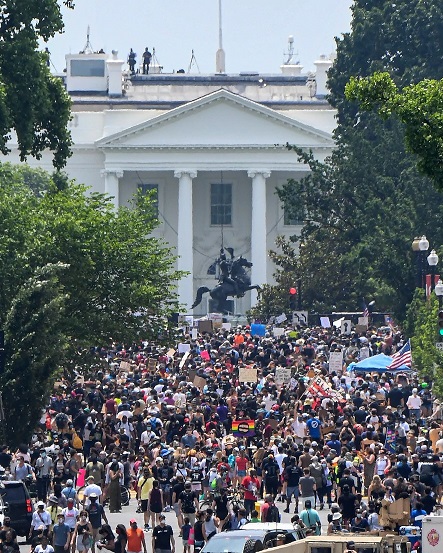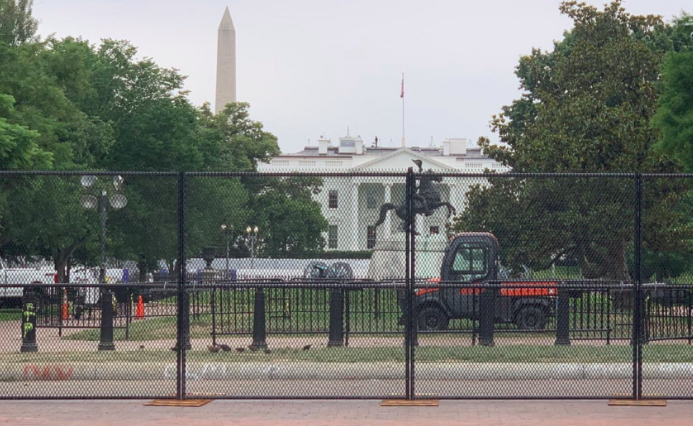More than 10,000 people poured into the nation’s capital on the ninth day of protests over police brutality, but what awaited this sprawling crowd — the largest yet in Washington — was a city that no longer felt as if it was being occupied by its own country’s military.
Gone were the 10-ton, sand-colored tankers in front of Lafayette Square and the legions of officers braced behind riot shields, insisting that citizens stay away. In fact, few police were visible anywhere.
And when protesters did see law enforcement — authorities in camouflage, grouped in twos or threes and seldom armed — they did not scream abuse, as many of them had in previous days.
Few of Saturday’s demonstrations were choreographed, as protesters flowed from one impromptu gathering or march to another.
Those who came out in Washington — and San Francisco, Chicago, Philadelphia and dozens of other cities across the country — understood that this was a moment in America when change seemed possible. They wanted to be there for it.
In city after city, both large and small, vast numbers of people clogged streets and halted traffic, circled government buildings and insisted that the leaders of their communities do more to protect the lives of black people.
At the same time that George Floyd was being memorialized in his North Carolina hometown 340 miles south, the crowd in Washington packed into six blocks along 16th Street NW to honor his life and condemn his death in police custody.
“No justice!” they chanted. “No peace!”
But the man in whose direction they shouted couldn’t hear them.
Nearly two miles of metal fencing now surrounded the White House, as if it had been locked in a cage, and inside, President Trump was raging.
He retweeted himself, sharing a message from the day before in which he described D.C. Mayor Muriel E. Bowser as “grossly incompetent, and in no way qualified to be running an important city like Washington, D.C.”
An hour later, nearly to the minute, Bowser (D) stood on the stretch of 16th she’d had painted with “Black Lives Matter” in huge yellow letters and named in the movement’s honor.
She denounced Trump administration officials for authorizing federal officers to fire chemical irritants and rubber bullets at peaceful protesters, clearing them from Lafayette Square so the president could get his photo taken with a Bible in front of St. John’s Episcopal Church. Now, on the section of fence there, hung protest signs, an American flag, and a torn yellow strip of police tape that read “Crime Scene.”
“Today we say no,” Bowser told the crowd. “In November, we say next.”
As they’d done all week, the protesters gathered near Lafayette Square, but also spread throughout the city.
They marched down U Street’s historic Black Broadway and past Chinatown’s brightly painted Friendship Arch.
They gathered on the Capitol lawn, beside the Mall’s Reflecting Pool and under the bronze Joan of Arc statue in Meridian Hill Park.
They knelt beneath the folded granite arms of the Rev. Martin Luther King Jr. and at the feet of Abraham Lincoln.
Their freedom to roam, unimpeded by police, was by design.
Almost all D.C. police were working or on call, a city official said, but they stayed away from demonstrators as much as possible.
With a swath of downtown cut off to traffic, it made it easier for police to monitor the demonstrations and easier for protesters to get around.
A buzz overhead, however, was a reminder of how different these streets had been just a few days earlier, when National Guard helicopters flew as low as a two-story building, scattering broken glass as they terrified the protesters and journalists beneath them.
“The battle space” was how Defense Secretary Mark T. Esper had described the city, but the resulting shows of force meant to send a clear message to protesters — stay home — had inspired them to do the opposite.
By today, the battle space had morphed into what felt like a carnival.
In New York City, large groups of health care workers joined the protests marching through Manhattan.
Elsewhere in New York state, a handful of counter protesters emerged a block from a Black Lives Matter protest in Bethpage carrying All Lives Matter Sign and wearing Make America Great Again hats.
Meanwhile in Philadelphia, the march was briefly interrupted by a newly wed couple who joined the protest still dressed in a wedding dress and suit.
In North Carolina, mourners and protesters stood side by side as a memorial and public viewing for George Floyd’s body was held.
Hundreds of cars lined up to pay their respects to the man whose death has sparked protests all over the world.
Demonstrations even emerged in the most unlikely of places.
Texas-based journalist Christopher Hooks reported that between 150 and 200 people took part in a Black Lives Matter rally in Vidor, an East Texas town that’s infamously associated with the Ku Klux Klan.
And in Arizona, about two dozens BLM supporters marched across the London Bridge in the Trump-friendly community of Lake Havasu.


